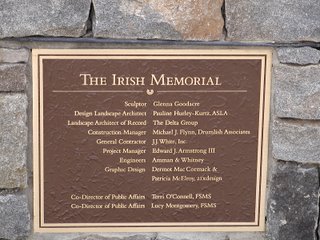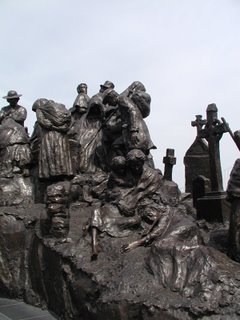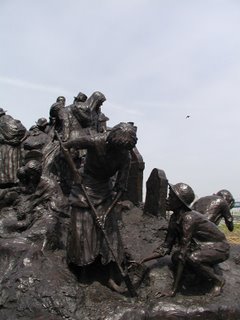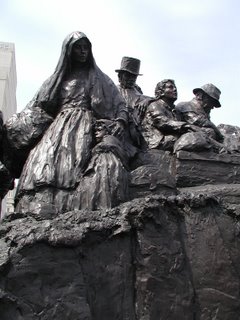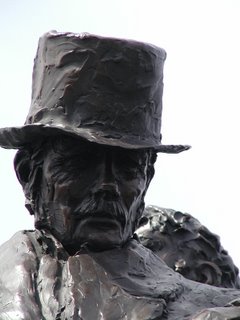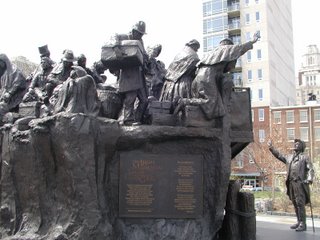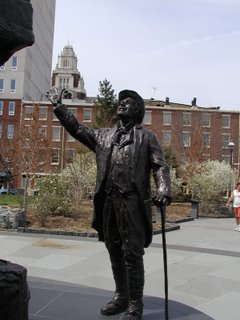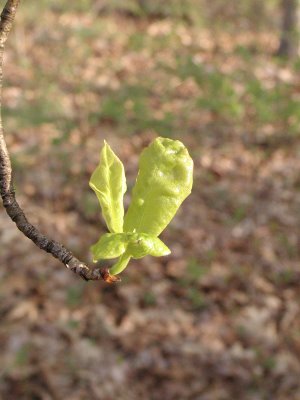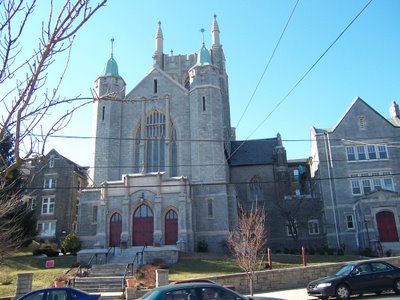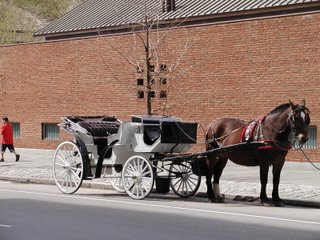 If Gas Prices Keep Rising.
If Gas Prices Keep Rising.
Sunday, April 30, 2006
The Irish Memorial In Philadelphia
Thursday, April 27, 2006
Strawberry Blonde
 Unlike his older brother Shaun who is a true blonde, our little Nikolas has tints of red in his blonde hair making him more of a strawberry blonde instead of a true blonde. And I might just want to proudly state "his Mom Mom had that very same strawberry blonde hair thing going when she was his age"
Unlike his older brother Shaun who is a true blonde, our little Nikolas has tints of red in his blonde hair making him more of a strawberry blonde instead of a true blonde. And I might just want to proudly state "his Mom Mom had that very same strawberry blonde hair thing going when she was his age"
Tuesday, April 25, 2006
Saturday, April 22, 2006
What Is In A Name?
“What is in a name? That which we call a rose: by any other name would smell so sweet”.
William Shakespeare
William, John, Mary and Ann, if you are a descendant of a Gallagher, chances are your name is one of the four and if it is not your first name chances are it is your middle name. Maybe your name is Marie or Anna. If you are a Gallagher descendant, it is considered just another form of Mary and Ann. Were you born a William? Then you are probably nicknamed Will, Bill or Billy. If your father was named William, chances are your first born son is also a William. Is your name John? Then you were named after many ancestors most probably your grandfather on both sides of the family or a favorite Uncle.
Names are given to us at birth or baptism. Surnames are the family name we carry throughout our lives and pass on to future generations. Do you know that the way you spell your surname today was probably not how it was spelled one hundred years ago? Surnames change for many different reasons but the most common reason a surname may change is because of language. Did you know the name Voigt is also spelled Voight and Voyt? I believe the correct spelling of our family form of this name is Voigt. My information comes directly from the Voigt headstones at Bethanien Lutheran Church Yard in Roxborough. These are the oldest ancestor graves to date. If you travel over to Westminster cemetery, you will discover another group of Voigt graves. Have you ever looked up the history of our cousin H.C. Voigt who fought at the Battle of Little Big Horn? If you did, it was spelled as Voyt on the list of soldiers wounded and killed at that battle. But, if you read the story of H.C. Voigt, you will notice that it was spelled Voigt. Do you know what H.C. stands for? It stands for Henry Charles, however, Henry Charles was not known as Henry but as simply Charles. John Keller was known as Jak. His wife Elisabeth spelled her name with an “s” instead of a “z”. Their daughter was given the name Maria Elisabeth at birth but was known as Mary her entire life. When Mary Keller married William Joseph Gallagher, they had two children William and Anna. They nicknamed William “Will” though through his life he was also called Bill. Anna Marie Gallagher married Collum McCaffery a man known as “Coll”. However, if you research his name in the Censes, you will also find it spelled Colum or Collin. His father was named Collum Owen but was known as Owen. When Anna Marie Gallagher married
Collum McCaffery she changed her name to Anna Marie McCaffery. When her brother William married Collum’s cousin Anna Marie McCaffery, then Anna Marie McCaffery became Anna Marie Gallagher. These two Anna’s actually switched last names.
What is in a name? Let me tell you. Sometimes the name you were given at birth may not be the name you were known as your entire life. Many of us grew up with a favorite nickname given to us by a friend or relative. My Uncle Gene used to call me “Patty Cake”, a nicknamed I carried into adulthood. Uncle Gene was not born with the name Gene; he was given the name Collum Eugene. He has two brothers, William Joseph and John Patrick. His brother William was called Billy while his brother John was called Jack. Some relatives were given nicknames that were not even close to their original birth names. My brother Michael was called “Ski”. Charles Schroeder was called “Dick”. His brother Elmer was called “Steve” whereas his brother Raymond was called “Mooney”. His sister Florence was known as “Hon” and Lillian was known as “Penny”.
Then you have surnames being changed all together like in the instance when my paternal grandfather John Wisloski decided to change his last name to Weleski.
What is the history behind our surnames? Did you know that at one time the surname Gallagher was spelled 30 different ways? Today, Gallagher is the most common name in Donegal, Ireland and the 14th most common name in all of Ireland. Gallagher is typically spelled as Gallegher, Gallaher, Galliger and Galligher. Did you know that the name Gallagher means “Foreign Helper or Assistant”? The story begins with a Gallagher in 1521 who willingly agrees to help the O’Donnell’s fight against the English. He fights to his death. (The World Book of Gallagher’s)
O’GALLCHOBHAIR
“Powerful sept allied to the O’Donnell’s and based in Ballybeit and Ballyneglock”
Other Irish surnames in our family are;
Boland, Bolan or O’Beollain is the “name of two Irish septs, one in Sligo and one in Clare”. Bolands from the Clare sept are direct descendants from the brother of the once High King of Ireland
Doherty, Docherty, Dougherty or O’Dogherty which means “unlucky” or “hurtful”. This surname is another popular name in Donegal as well as Derry.
McCaffery, Caffery, Caffray, Caffrey, Caffry, McCaffrey, MacCaffery or MacGafraigh is a “sept related to Maguire of Fermanagh”. This name is common in Dublin and the Midlands.
Cannon, MacCaunneen, O’Cunneen, Cuneen, Queenan, Queenane, Cunneany, Cunnien, Cunneen, Cunnion, Kinnen, Robbett, Rabbit, Kenyon, Kinnane or MacCoinin is “that of a literary family of Earris, County Mayo. It is Anglicized Kenning and Kenyon as well as Cunneen and is also translated as Rabbit”. (Bill Cannon)
When a surname begins with the letter “O” it states the surname was a descendant of. When a surname begins with the letters Mc, M or Mac the person is a son of. Many of the Irish dropped these letters in front of their name to avoid persecution. (The World Book of Gallagher’s)
Even the country from which the Irish emigrated from has a meaning to its name. Ireland means Erie in Gaelic and Erin in English. It is also referred to as the “Emerald Isle” because of the beauty of its countryside.
The term we use when researching a surname is Onomastics which is defined as the study of the surname or last name and where it came from and what the name means.
What is your given name or first name? Is it Celtic or Teutonic? Maybe it’s from the
Hebrew language? Given names or as we call them first names originated from five
Languages: Hebrew, Teutonic, Greek, Latin and Celtic. (The World Book of Gallagher’s)
The most popular first names used in English speaking countries are Elizabeth, Mary, John and Joseph. How many family members do we have with those names? Are your relatives from Donegal? If so they may have one of Donegal’s most popular first names such as Eugene, Kathleen, Mary, Charles, Francis, Patrick, Hannah, Daniel, Sean, Joseph, William, John or Brigrid. If you have relatives from County Mayo, you might expect them to have the following names such as Daniel, Bridget, Ellen, John, Catherine, Mary, Ann, Francis or Patrick
If you do not have one of the popular Donegal or County Mayo first names, your name still has a meaning and some parents name their children a particular name because of what it stands for such as Matthew “gift of God” or Michael “God like”. Paul stands for “Little” or Henry “Ruler of the home”. My name Patricia means “Of noble birth”.
In additional to our Irish surnames, we also have German surnames that originated from the occupation or birth place. You may be called Frank of East Falls or simply Frank Maier. If you were of the nobility then you would have a middle name. You would be called Frank William Maier.
The Polish surnames have distinct endings. The “ski” or “orock” that comes at the end of a Polish surname is originally from the nobility to distinguish themselves from the common folk. But, it is of interest that Polish surnames all have German beginnings. (The World Book of Gallagher’s)
William, John, Mary or Ann are common Ancestral Gallagher names in our family that were started by our Gallagher descendants Patrick and Hannah and the tale goes like this.
Patrick and Hannah had a daughter named Mary and a son named William, William married a girl named Mary who was born Maria and she had a father and brother named John. Their children are called William and Anna Marie. William whose sister is called Anna Marie who had a daughter named Mary married a girl also called Anna Marie who had a father and uncle named John then they had their own William, John, Mary and Ann Marie. William had his own son William and a daughter named Katherine Mary who one day had her own daughter Mary Kate. John had a son John and another whom he called Paul William. However, his other son Eric when he had his own son called him William. Mary had a son Francis William who had his own Francis William and another one called John. Her daughter Patricia Marie named one of her own sons Joseph William, Mary also had a daughter Mary Ann who one day had a daughter Christine Mary. The youngest daughter of William and Anna Marie who was called Ann Marie had a daughter whom she called Angelina Marie.
Nine Williams, seven Johns, twelve forms of Mary and five forms of Ann born over six generations. What are the newest Gallagher members being named today? The new trend seems to give last names as first names to their children such as Kendal, Finnegan and Reilly.
William Shakespeare
William, John, Mary and Ann, if you are a descendant of a Gallagher, chances are your name is one of the four and if it is not your first name chances are it is your middle name. Maybe your name is Marie or Anna. If you are a Gallagher descendant, it is considered just another form of Mary and Ann. Were you born a William? Then you are probably nicknamed Will, Bill or Billy. If your father was named William, chances are your first born son is also a William. Is your name John? Then you were named after many ancestors most probably your grandfather on both sides of the family or a favorite Uncle.
Names are given to us at birth or baptism. Surnames are the family name we carry throughout our lives and pass on to future generations. Do you know that the way you spell your surname today was probably not how it was spelled one hundred years ago? Surnames change for many different reasons but the most common reason a surname may change is because of language. Did you know the name Voigt is also spelled Voight and Voyt? I believe the correct spelling of our family form of this name is Voigt. My information comes directly from the Voigt headstones at Bethanien Lutheran Church Yard in Roxborough. These are the oldest ancestor graves to date. If you travel over to Westminster cemetery, you will discover another group of Voigt graves. Have you ever looked up the history of our cousin H.C. Voigt who fought at the Battle of Little Big Horn? If you did, it was spelled as Voyt on the list of soldiers wounded and killed at that battle. But, if you read the story of H.C. Voigt, you will notice that it was spelled Voigt. Do you know what H.C. stands for? It stands for Henry Charles, however, Henry Charles was not known as Henry but as simply Charles. John Keller was known as Jak. His wife Elisabeth spelled her name with an “s” instead of a “z”. Their daughter was given the name Maria Elisabeth at birth but was known as Mary her entire life. When Mary Keller married William Joseph Gallagher, they had two children William and Anna. They nicknamed William “Will” though through his life he was also called Bill. Anna Marie Gallagher married Collum McCaffery a man known as “Coll”. However, if you research his name in the Censes, you will also find it spelled Colum or Collin. His father was named Collum Owen but was known as Owen. When Anna Marie Gallagher married
Collum McCaffery she changed her name to Anna Marie McCaffery. When her brother William married Collum’s cousin Anna Marie McCaffery, then Anna Marie McCaffery became Anna Marie Gallagher. These two Anna’s actually switched last names.
What is in a name? Let me tell you. Sometimes the name you were given at birth may not be the name you were known as your entire life. Many of us grew up with a favorite nickname given to us by a friend or relative. My Uncle Gene used to call me “Patty Cake”, a nicknamed I carried into adulthood. Uncle Gene was not born with the name Gene; he was given the name Collum Eugene. He has two brothers, William Joseph and John Patrick. His brother William was called Billy while his brother John was called Jack. Some relatives were given nicknames that were not even close to their original birth names. My brother Michael was called “Ski”. Charles Schroeder was called “Dick”. His brother Elmer was called “Steve” whereas his brother Raymond was called “Mooney”. His sister Florence was known as “Hon” and Lillian was known as “Penny”.
Then you have surnames being changed all together like in the instance when my paternal grandfather John Wisloski decided to change his last name to Weleski.
What is the history behind our surnames? Did you know that at one time the surname Gallagher was spelled 30 different ways? Today, Gallagher is the most common name in Donegal, Ireland and the 14th most common name in all of Ireland. Gallagher is typically spelled as Gallegher, Gallaher, Galliger and Galligher. Did you know that the name Gallagher means “Foreign Helper or Assistant”? The story begins with a Gallagher in 1521 who willingly agrees to help the O’Donnell’s fight against the English. He fights to his death. (The World Book of Gallagher’s)
O’GALLCHOBHAIR
“Powerful sept allied to the O’Donnell’s and based in Ballybeit and Ballyneglock”
Other Irish surnames in our family are;
Boland, Bolan or O’Beollain is the “name of two Irish septs, one in Sligo and one in Clare”. Bolands from the Clare sept are direct descendants from the brother of the once High King of Ireland
Doherty, Docherty, Dougherty or O’Dogherty which means “unlucky” or “hurtful”. This surname is another popular name in Donegal as well as Derry.
McCaffery, Caffery, Caffray, Caffrey, Caffry, McCaffrey, MacCaffery or MacGafraigh is a “sept related to Maguire of Fermanagh”. This name is common in Dublin and the Midlands.
Cannon, MacCaunneen, O’Cunneen, Cuneen, Queenan, Queenane, Cunneany, Cunnien, Cunneen, Cunnion, Kinnen, Robbett, Rabbit, Kenyon, Kinnane or MacCoinin is “that of a literary family of Earris, County Mayo. It is Anglicized Kenning and Kenyon as well as Cunneen and is also translated as Rabbit”. (Bill Cannon)
When a surname begins with the letter “O” it states the surname was a descendant of. When a surname begins with the letters Mc, M or Mac the person is a son of. Many of the Irish dropped these letters in front of their name to avoid persecution. (The World Book of Gallagher’s)
Even the country from which the Irish emigrated from has a meaning to its name. Ireland means Erie in Gaelic and Erin in English. It is also referred to as the “Emerald Isle” because of the beauty of its countryside.
The term we use when researching a surname is Onomastics which is defined as the study of the surname or last name and where it came from and what the name means.
What is your given name or first name? Is it Celtic or Teutonic? Maybe it’s from the
Hebrew language? Given names or as we call them first names originated from five
Languages: Hebrew, Teutonic, Greek, Latin and Celtic. (The World Book of Gallagher’s)
The most popular first names used in English speaking countries are Elizabeth, Mary, John and Joseph. How many family members do we have with those names? Are your relatives from Donegal? If so they may have one of Donegal’s most popular first names such as Eugene, Kathleen, Mary, Charles, Francis, Patrick, Hannah, Daniel, Sean, Joseph, William, John or Brigrid. If you have relatives from County Mayo, you might expect them to have the following names such as Daniel, Bridget, Ellen, John, Catherine, Mary, Ann, Francis or Patrick
If you do not have one of the popular Donegal or County Mayo first names, your name still has a meaning and some parents name their children a particular name because of what it stands for such as Matthew “gift of God” or Michael “God like”. Paul stands for “Little” or Henry “Ruler of the home”. My name Patricia means “Of noble birth”.
In additional to our Irish surnames, we also have German surnames that originated from the occupation or birth place. You may be called Frank of East Falls or simply Frank Maier. If you were of the nobility then you would have a middle name. You would be called Frank William Maier.
The Polish surnames have distinct endings. The “ski” or “orock” that comes at the end of a Polish surname is originally from the nobility to distinguish themselves from the common folk. But, it is of interest that Polish surnames all have German beginnings. (The World Book of Gallagher’s)
William, John, Mary or Ann are common Ancestral Gallagher names in our family that were started by our Gallagher descendants Patrick and Hannah and the tale goes like this.
Patrick and Hannah had a daughter named Mary and a son named William, William married a girl named Mary who was born Maria and she had a father and brother named John. Their children are called William and Anna Marie. William whose sister is called Anna Marie who had a daughter named Mary married a girl also called Anna Marie who had a father and uncle named John then they had their own William, John, Mary and Ann Marie. William had his own son William and a daughter named Katherine Mary who one day had her own daughter Mary Kate. John had a son John and another whom he called Paul William. However, his other son Eric when he had his own son called him William. Mary had a son Francis William who had his own Francis William and another one called John. Her daughter Patricia Marie named one of her own sons Joseph William, Mary also had a daughter Mary Ann who one day had a daughter Christine Mary. The youngest daughter of William and Anna Marie who was called Ann Marie had a daughter whom she called Angelina Marie.
Nine Williams, seven Johns, twelve forms of Mary and five forms of Ann born over six generations. What are the newest Gallagher members being named today? The new trend seems to give last names as first names to their children such as Kendal, Finnegan and Reilly.
Thursday, April 20, 2006
Origin Of Irish First Names
I came across an interesting piece of research on popular Irish names and how they became popular so I thought I would share it with those of you who have an interest in such things.
Popular Christian Names
When Ireland was converted to Christianity by St. Patrick, children were named Christian names. Popular Christian names were Patrick, Patricia, Paul, Andrew and Aaron.
Popular German Saxon Names
When the Norse invaded Ireland in the 12th century, names had a Germanic Saxon origin. Popular German Saxon names were Robert, William, Richard and Gerard.
Popular Gaelic Names
Gaelic names became popular in the late 19th century and early 20th century. These names came from the myths and legends in Ireland. Popular Gaelic names were Shane, Seamus, Ryan, Aine, Brian and Niall.
Modern Irish Names
Today, names that were never popular in Ireland have become popular now. These names are Kyle, Ethan, Dillon, Cameron and Reece.
Ten Most Popular Irish Boy's Names
Conor, Sean, Jack, James, Adam, Michael, David, Aaron, Daniel and Dylan
Ten Most Popular Irish Girl's Names
Chloe, Aoife, Sarah, Ciara, Niamh, Emma, Rachel, Rebecca, Lauren and Megan
Where Does The Popular Family Names In Our Family Rank
William comes in at # 50
John comes in at #15
Mary comes in at #37
Ann comes in at #28
Popular Christian Names
When Ireland was converted to Christianity by St. Patrick, children were named Christian names. Popular Christian names were Patrick, Patricia, Paul, Andrew and Aaron.
Popular German Saxon Names
When the Norse invaded Ireland in the 12th century, names had a Germanic Saxon origin. Popular German Saxon names were Robert, William, Richard and Gerard.
Popular Gaelic Names
Gaelic names became popular in the late 19th century and early 20th century. These names came from the myths and legends in Ireland. Popular Gaelic names were Shane, Seamus, Ryan, Aine, Brian and Niall.
Modern Irish Names
Today, names that were never popular in Ireland have become popular now. These names are Kyle, Ethan, Dillon, Cameron and Reece.
Ten Most Popular Irish Boy's Names
Conor, Sean, Jack, James, Adam, Michael, David, Aaron, Daniel and Dylan
Ten Most Popular Irish Girl's Names
Chloe, Aoife, Sarah, Ciara, Niamh, Emma, Rachel, Rebecca, Lauren and Megan
Where Does The Popular Family Names In Our Family Rank
William comes in at # 50
John comes in at #15
Mary comes in at #37
Ann comes in at #28
Saturday, April 15, 2006
William Joseph Gallagher 1906-1980
Honoring An Honorable Man
With Easter fast approaching and falling this year on the 16th of April, it reminds me of another Easter one hundred years ago. It was on April 15th, 1906 when my grandfather William Joseph Gallagher II was born to William and Mary (Keller) Gallagher on an Easter Sunday.
It has been nearly twenty six years since my grandfather died but his life lives on in the memories of those who loved and adored and knew him as I was lucky enough to have done. When I think of my grandfather, I remember his twinkling laughing brown eyes that lit up his entire face. I remember a man so strong in bodily presence that when he entered a room, he surrounded it with strength of character. He was quiet but powerful and listened intently to those around him. This is his story.
Born on an Easter Sunday one hundred years ago, William Joseph Gallagher was the son of an Irish Catholic father and a German Lutheran born mother. Baptized on April 29th, 1906 at St. John the Baptist Catholic Church, his godparents were George and Mary Cannon. (Mary Cannon was his paternal aunt) William was joined eighteen months later by a sister Anna Marie Gallagher born November 5th, 1907. William did have another sibling Patrick John Gallagher who died shortly after birth.
William had two nicknames as child. He was called Will by his family but was known as Bill by his friends. William attended St. John the Baptist Church and its parish grade school up to the 8th grade before leaving his education behind and entering the workforce to make a living. (most children from the working class left school at young ages to work in local factories in the early 20th century)
William worked in Pencoyd Iron Works located in what was once known as West Manayunk. (today it is called Lower Merion Township) He could perform a variety of duties at the works from melting iron to creating steel. Also employed at Pencoyd was his father William and before his death in 1890 his maternal grandfather John Keller. William married Anna Marie McCaffery in 1928 and in 1931 had his first child and son William Joseph Gallagher III. In the early 1930’s, Pencoyd Iron Works wanted to send William to its South Africa plant but family pressure lead him to decline the opportunity which he later regretted because as the Great Depression descended on the country, William lost his job at Pencoyd. (it should be noted that while at Pencoyd, William made the steel for the construction of the Benjamin Franklin Bridge that expands from Center City Philadelphia over the Delaware River and into Camden New Jersey) The next ten years turned out to be a great struggle for him and his family as he looked for work and made ends meat by doing a variety of odd jobs. He was known to walk each morning from his Manayunk home to Germantown just to wait outside the Salvation Army building to get called for a day’s worth of work to feed his family. During these Depression years he had three more children John Patrick born in 1933, Collum Eugene born in 1935 and Mary Louise born in 1938. He had one more child in 1942 Ann Marie. Before the birth of his fifth and last child Ann Marie, William was hired at Midvale Steel in the Nicetown Section of Philadelphia. The country entered World War II and the once idle factories of the Depression prospered once again with orders from the government for military supplies. Midvale Steel was a viable plant until the late 1960’s when once again economic outsourcing caused the failure then subsequencial closures of steel mills and factories.
But during his days at Midvale Steel, William was deeply respected for his work ethics. He was not afraid of heights and ran what was known at the time ‘the highest crane in the country in the tallest one story building in the world” This crane and its operator took large pieces of steel and placed them in large processors to make the Navy’s Battleship gun turrets. This job at the mill was considered “very dangerous” and only those “highly experienced operators” could do this type of work. It was not until my grandfather’s death November 27th, 1980 we his family really understood the respect others had for him.
My grandfather’s viewing was held on the evening of November 30th, 1980 at the funeral home. I remember the weather as being very cold. I remember walking into the funeral home with my parents and grandmother and remember how my grandmother walked up to my grandfather’s casket, knelt down and touched his face and cried out “Oh Daddy” as the tears rolled down her face and fell down onto the front of her black dress. After a private “family only” visit, the doors were opened and those who wanted to pay their respects came in. The usual family members and friends came through the doors but in addition to them were the former coworkers who twenty to thirty years before worked with my grandfather but who had not seen him in years. One after another entered through the double doors, knelt at his casket then went over to my grandmother and expressed their condolences. They told my grandmother that when one coworker saw the obituary in the local newspaper and learned of my grandfather’s death, the word was spread and everyone who had worked with my grandfather at Midvale and who was still living made the trip up to the Northeast section of Philadelphia to pay their respects to the family of a man who touched their lives in many different ways.
William was an active outdoorsman who loved to hunt in the Allegheny Mountains and fish in every available body of water within his reach. In the earlier days of his life, he went hunting with his brother-in-law Coll McCaffery who happened to also be his wife’s cousin. They hunted deer, rabbit and pheasant and on occasion had a few run-ins with bear. The latter created the foundation for many childhood stories and tales to be told to his future grandchildren. As a young man he went fishing in the Wissahickon creek and continued to do so into his later fifties. More then once he took along his two eldest grandchildren, one being me. I remember getting up before dawn, grabbing a blanket and following my grandfather who had pole and bucket in hand as we walked in the woods of the Wissahickon to get to that perfect fishing spot. As he set up his pole, I found myself a comfortable spot, wrapped the blanket around me and went to sleep until the sun was high in the sky. When I awoke, grand pop usually had several catfish in that bucket. Later he fished in local ponds or other creeks but I did not go fishing with him again until the summer of 1976 when at age sixteen I flew out to California to spend the summer with my Gallagher cousins and my grandparents who had been out there in Newport Beach for just under a year. Out there off the pier over the Pacific Ocean, I did take up the rod and tried my hand at fishing though quite frankly I do not remember catching one blessed thing. It was in California that my grandfather introduced my younger cousin Eric to the art of fishing and without a doubt this younger cousin did better then me at the art.
For as long as I remember, my grandparents had a pet. Sometimes they had a dog. Sometimes they had a cat. Sometimes they even had both. However, because my grandfather had a soft spot for anything furry, that furry creature usually made its way into the family home. Oh yes, William had a soft spot for strays and those strays were usually of the canine variety and these canines (scrawny and skinny) were often found wandering around the tracks at Midvale and more often then not were taken home (to my grandmother’s horror) and placed in the backyard of the family home. Of course, this was during the days when dyers were a luxury and clothes were hung out side on clothes lines. You can probably guess what I am about to say next. In the early morning hours as grandmom crossed the yard with basket in hand to hang the clothes out, she often stepped in a pile of something the dog left behind that caused this Irish Catholic woman to scream out in horror only those words said in a bar full of drunken men during a boxing match.
Did I mention William loved the horse races? Like every other Irish blooded Gallagher, William loved the horse races so much that the radio was on each and every time there was a horse race. Nothing like sitting down at the dinner table eating a meal when a Gallagher of the male sex jumps up from the table yelling for his horse to reach the finish line first.(Like the horse could hear him). Did I mention the newspaper of choice in the Gallagher home was a Racing Form? And finally, did I mention all three of William’s sons followed in his foot steps? It seems lately that every time I call my Uncle Jack (Gallagher) in Texas, he is at a horse race. I know Uncle Gene is not much different and when my Uncle Bill was alive, he spent his fair share of time at a race track.
Fishing was not the only sport grand pop taught me. He taught me how to shoot pool. During that same summer of 1976 in California, grand pop taught me to play pool and play well. Grand pop also taught me how to protect myself in both the physical and mental way. He taught me where to hit a man if attacked outside. “Poke him in the eyes then kick him in the balls screaming at the top of your lungs”, he said. He taught me the value of a woman having a career because a woman always needs something to fall back on if her husband dies or leaves her. “Learn a trade”, he said. “You never know what the future holds”, pretty modern words and thoughts for a man born just after the turn of the 20th century.
There are some funny memories of grand pop. Like when we took walks in the Local Park and grand pop always told me to carry a big stick just in case we were attacked by wild dogs. I never recalled being attacked by anything especially wild dogs. Or when grand pop was trying to hide alcohol from grandmom by pouring the alcohol (brandy) into a 7UP bottle and drinking it at a party I was having for my oldest son’s baptism. I clearly remember grandmom telling me how proud she was of grand pop for drinking soda not alcohol like everyone else. She discovered the deception hours’ later when grand pop appeared a little tipsy then asked me to drive her home without him. Later that evening, we received a telephone call from Uncle Gene telling us grand pop was happily sitting on a neighbor’s lawn and he could not get him to move.
Devoted to family and loved everything life had to offer is how I remember grand pop. Born to an Irish born father and a German born mother, this little boy learned the value of a hard day’s work from his mother, the value of enjoying life from his father and the value of cherishing family for as long as you live. He found love with Anna Marie McCaffery which lasted fifty two years and pleasure in raising his five children. He believed in God. He believed in his country and stood with hand over his heart anytime the National Anthem was played no matter where he was or what he was doing. He was funny and serious and today on his 100th birthday, I want to honor this man as he was one of the last truly honorable men I have known and I am so proud to have called this man, my grandfather.
Post Note; at the time of William’s death in 1980, he left behind his wife Anna, his five children, fifteen grandchildren and two great grandchildren.
It has been nearly twenty six years since my grandfather died but his life lives on in the memories of those who loved and adored and knew him as I was lucky enough to have done. When I think of my grandfather, I remember his twinkling laughing brown eyes that lit up his entire face. I remember a man so strong in bodily presence that when he entered a room, he surrounded it with strength of character. He was quiet but powerful and listened intently to those around him. This is his story.
Born on an Easter Sunday one hundred years ago, William Joseph Gallagher was the son of an Irish Catholic father and a German Lutheran born mother. Baptized on April 29th, 1906 at St. John the Baptist Catholic Church, his godparents were George and Mary Cannon. (Mary Cannon was his paternal aunt) William was joined eighteen months later by a sister Anna Marie Gallagher born November 5th, 1907. William did have another sibling Patrick John Gallagher who died shortly after birth.
William had two nicknames as child. He was called Will by his family but was known as Bill by his friends. William attended St. John the Baptist Church and its parish grade school up to the 8th grade before leaving his education behind and entering the workforce to make a living. (most children from the working class left school at young ages to work in local factories in the early 20th century)
William worked in Pencoyd Iron Works located in what was once known as West Manayunk. (today it is called Lower Merion Township) He could perform a variety of duties at the works from melting iron to creating steel. Also employed at Pencoyd was his father William and before his death in 1890 his maternal grandfather John Keller. William married Anna Marie McCaffery in 1928 and in 1931 had his first child and son William Joseph Gallagher III. In the early 1930’s, Pencoyd Iron Works wanted to send William to its South Africa plant but family pressure lead him to decline the opportunity which he later regretted because as the Great Depression descended on the country, William lost his job at Pencoyd. (it should be noted that while at Pencoyd, William made the steel for the construction of the Benjamin Franklin Bridge that expands from Center City Philadelphia over the Delaware River and into Camden New Jersey) The next ten years turned out to be a great struggle for him and his family as he looked for work and made ends meat by doing a variety of odd jobs. He was known to walk each morning from his Manayunk home to Germantown just to wait outside the Salvation Army building to get called for a day’s worth of work to feed his family. During these Depression years he had three more children John Patrick born in 1933, Collum Eugene born in 1935 and Mary Louise born in 1938. He had one more child in 1942 Ann Marie. Before the birth of his fifth and last child Ann Marie, William was hired at Midvale Steel in the Nicetown Section of Philadelphia. The country entered World War II and the once idle factories of the Depression prospered once again with orders from the government for military supplies. Midvale Steel was a viable plant until the late 1960’s when once again economic outsourcing caused the failure then subsequencial closures of steel mills and factories.
But during his days at Midvale Steel, William was deeply respected for his work ethics. He was not afraid of heights and ran what was known at the time ‘the highest crane in the country in the tallest one story building in the world” This crane and its operator took large pieces of steel and placed them in large processors to make the Navy’s Battleship gun turrets. This job at the mill was considered “very dangerous” and only those “highly experienced operators” could do this type of work. It was not until my grandfather’s death November 27th, 1980 we his family really understood the respect others had for him.
My grandfather’s viewing was held on the evening of November 30th, 1980 at the funeral home. I remember the weather as being very cold. I remember walking into the funeral home with my parents and grandmother and remember how my grandmother walked up to my grandfather’s casket, knelt down and touched his face and cried out “Oh Daddy” as the tears rolled down her face and fell down onto the front of her black dress. After a private “family only” visit, the doors were opened and those who wanted to pay their respects came in. The usual family members and friends came through the doors but in addition to them were the former coworkers who twenty to thirty years before worked with my grandfather but who had not seen him in years. One after another entered through the double doors, knelt at his casket then went over to my grandmother and expressed their condolences. They told my grandmother that when one coworker saw the obituary in the local newspaper and learned of my grandfather’s death, the word was spread and everyone who had worked with my grandfather at Midvale and who was still living made the trip up to the Northeast section of Philadelphia to pay their respects to the family of a man who touched their lives in many different ways.
William was an active outdoorsman who loved to hunt in the Allegheny Mountains and fish in every available body of water within his reach. In the earlier days of his life, he went hunting with his brother-in-law Coll McCaffery who happened to also be his wife’s cousin. They hunted deer, rabbit and pheasant and on occasion had a few run-ins with bear. The latter created the foundation for many childhood stories and tales to be told to his future grandchildren. As a young man he went fishing in the Wissahickon creek and continued to do so into his later fifties. More then once he took along his two eldest grandchildren, one being me. I remember getting up before dawn, grabbing a blanket and following my grandfather who had pole and bucket in hand as we walked in the woods of the Wissahickon to get to that perfect fishing spot. As he set up his pole, I found myself a comfortable spot, wrapped the blanket around me and went to sleep until the sun was high in the sky. When I awoke, grand pop usually had several catfish in that bucket. Later he fished in local ponds or other creeks but I did not go fishing with him again until the summer of 1976 when at age sixteen I flew out to California to spend the summer with my Gallagher cousins and my grandparents who had been out there in Newport Beach for just under a year. Out there off the pier over the Pacific Ocean, I did take up the rod and tried my hand at fishing though quite frankly I do not remember catching one blessed thing. It was in California that my grandfather introduced my younger cousin Eric to the art of fishing and without a doubt this younger cousin did better then me at the art.
For as long as I remember, my grandparents had a pet. Sometimes they had a dog. Sometimes they had a cat. Sometimes they even had both. However, because my grandfather had a soft spot for anything furry, that furry creature usually made its way into the family home. Oh yes, William had a soft spot for strays and those strays were usually of the canine variety and these canines (scrawny and skinny) were often found wandering around the tracks at Midvale and more often then not were taken home (to my grandmother’s horror) and placed in the backyard of the family home. Of course, this was during the days when dyers were a luxury and clothes were hung out side on clothes lines. You can probably guess what I am about to say next. In the early morning hours as grandmom crossed the yard with basket in hand to hang the clothes out, she often stepped in a pile of something the dog left behind that caused this Irish Catholic woman to scream out in horror only those words said in a bar full of drunken men during a boxing match.
Did I mention William loved the horse races? Like every other Irish blooded Gallagher, William loved the horse races so much that the radio was on each and every time there was a horse race. Nothing like sitting down at the dinner table eating a meal when a Gallagher of the male sex jumps up from the table yelling for his horse to reach the finish line first.(Like the horse could hear him). Did I mention the newspaper of choice in the Gallagher home was a Racing Form? And finally, did I mention all three of William’s sons followed in his foot steps? It seems lately that every time I call my Uncle Jack (Gallagher) in Texas, he is at a horse race. I know Uncle Gene is not much different and when my Uncle Bill was alive, he spent his fair share of time at a race track.
Fishing was not the only sport grand pop taught me. He taught me how to shoot pool. During that same summer of 1976 in California, grand pop taught me to play pool and play well. Grand pop also taught me how to protect myself in both the physical and mental way. He taught me where to hit a man if attacked outside. “Poke him in the eyes then kick him in the balls screaming at the top of your lungs”, he said. He taught me the value of a woman having a career because a woman always needs something to fall back on if her husband dies or leaves her. “Learn a trade”, he said. “You never know what the future holds”, pretty modern words and thoughts for a man born just after the turn of the 20th century.
There are some funny memories of grand pop. Like when we took walks in the Local Park and grand pop always told me to carry a big stick just in case we were attacked by wild dogs. I never recalled being attacked by anything especially wild dogs. Or when grand pop was trying to hide alcohol from grandmom by pouring the alcohol (brandy) into a 7UP bottle and drinking it at a party I was having for my oldest son’s baptism. I clearly remember grandmom telling me how proud she was of grand pop for drinking soda not alcohol like everyone else. She discovered the deception hours’ later when grand pop appeared a little tipsy then asked me to drive her home without him. Later that evening, we received a telephone call from Uncle Gene telling us grand pop was happily sitting on a neighbor’s lawn and he could not get him to move.
Devoted to family and loved everything life had to offer is how I remember grand pop. Born to an Irish born father and a German born mother, this little boy learned the value of a hard day’s work from his mother, the value of enjoying life from his father and the value of cherishing family for as long as you live. He found love with Anna Marie McCaffery which lasted fifty two years and pleasure in raising his five children. He believed in God. He believed in his country and stood with hand over his heart anytime the National Anthem was played no matter where he was or what he was doing. He was funny and serious and today on his 100th birthday, I want to honor this man as he was one of the last truly honorable men I have known and I am so proud to have called this man, my grandfather.
Post Note; at the time of William’s death in 1980, he left behind his wife Anna, his five children, fifteen grandchildren and two great grandchildren.
Sunday, April 09, 2006
Final Article On The Series Of East Falls
 1900 Photograph of Ridge Avenue (Trolley car is on Ridge Avenue) This section of Ridge Avenue is just below Wissahickon Creek Falls going towards Manayunk/Roxborough. Gustine Lake is the body of water in the background .
1900 Photograph of Ridge Avenue (Trolley car is on Ridge Avenue) This section of Ridge Avenue is just below Wissahickon Creek Falls going towards Manayunk/Roxborough. Gustine Lake is the body of water in the background .Though there are many places still to visit, review and discuss in the East Falls Section of Philadelphia, I will close out this series with one last article on the "Street" Ridge Avenue itself.
Ridge Avenue is a natural highway that was once called a "well established Indian Path" that ran from the City to the Countryside for more then three hundred years.
First called "Kings Road" in the 1700's, it underwent many name changes before it was finally called Ridge Avenue. Names included but were not limited to were; Manatawny Road, Reading Turnpike, Robeson's Road, Rocks Burrow, Wissahickon Road, Rich Road, Ridge Road and Ridge Road Turnpike.
History Of Gustine Lake
 Arthur Ashe Youth Tennis Center (constructed on the grounds of the old Gustine Lake)
Arthur Ashe Youth Tennis Center (constructed on the grounds of the old Gustine Lake) 1950 Photograph of Gustine Lake
1950 Photograph of Gustine Lake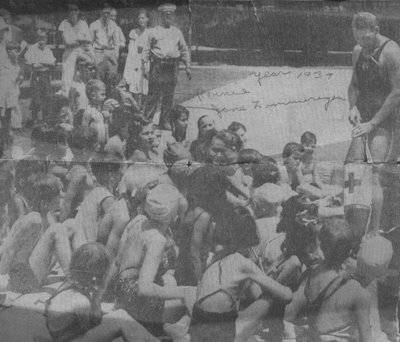 My Father Ronald Weleski (age 5yrs) 1939 Photograph at Gustine Lake
My Father Ronald Weleski (age 5yrs) 1939 Photograph at Gustine Lake Closeup Photograph of Ronald Weleski at Gustine Lake in 1939
Closeup Photograph of Ronald Weleski at Gustine Lake in 1939Manmade lake once located at the 4200 block of Ridge Avenue just below the Wissahickon Falls and near where the Wissahickon Creek dumps into the Schuylkill River. The lake was fed by the waters of the Wissahickon Creek for many years until the lake was drained and a pool built on the same grounds.
For many years, Gustine Lake was the public waterhole for those living in the East Falls and surrounding areas during those hot summers before the invention of modern Air conditioners.
During the heighten concerns of the polio epidemic between the years 1932 to 1950, many families avoided the public waterhole during the the last weeks of August thu to the first two weeks of September when polio outbreaks were at their highest.
Today, the grounds of Gustine Lake are undergoing the construction of the Arthur Ashe Youth Tennis Center.
Labels:
East Falls,
Gallagher,
Gustine Lake,
Wisloski/Weleski
Saturday, April 08, 2006
History Of Laurel Hill Cemetery
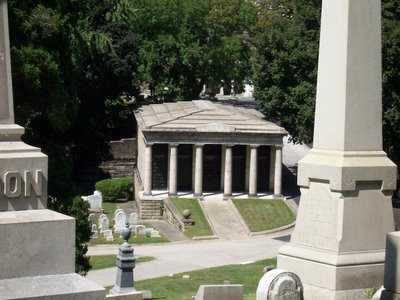
In 1835, the North Section was once the country estate of Joseph Sim. The Central section of the cemetery was once the estate of George Worten Pepper. Before, his estate was taken over by the cemetery, it held Laurel Hill College for men and contained a Catholic College Chapel on its grounds.
When Laurel Hill was founded in 1836 by John Jay Smith it was the first rural cemetery in Philadelphia and the country's second only rural Victorian Garden cemetery of its kind known for its architectural structure and beauty. Before 1836, burials took place in Church yard cemeteries and on the grounds of estates.
There are many notable Philadelphians buried at Laurel Hill. 19th Century Industrialists and Civil War Generals are just a few of those interred in its grounds.
In the late 1960s, the cemetery fell in disarray and it was not until the Friends' group was established that the cemetery began to return to its original splendor. Because of the hard work and dedication of the Laurel Hill Friend's group, the cemetery became a National Historic Landmark in 1998 which I proudly was a part of. The formal dedication of the Pennsylvania Historical Marker took place on May 7th, 2000.
In the years that followed, I began writing articles for the cemetery's newsletter about the ordinary folks interred in Laurel Hill and also about those whom the cemetery 's existence played a part in their lives. I personaaly thought too much attention was placed on the "Rich and Famous" and not enough on the "Ordinary Folks' interred in the cemetery and I wanted it known that though the cemetery may focus on the first group, there was even a larger group of ordinary everyday folks who were interred in its grounds that may not have been as wealthy or policitally connected but who also served an importance in the local community as well.
I am sad to say that today the cemetery has turned from a place of quiet historical beauty to a place of commercialism.
History Of St. Bridget's Catholic Church
Thursday, April 06, 2006
History Of The Falls Housing Project
 East Falls Housing Project
East Falls Housing ProjectBefore the City of Philadelphia built the East Falls housing project , the land was own and occupied by a 19th century chemical plant which provided houses for the workman and their families up on the hill behind the plant. This section of East Falls was known as Laboratory Hill.
The chemical plant made alcohol which caused the production of many obnoxious gases. During the Civil War, the plant made a lot of money because of the high cost of quinine that was used.
Laboratory Hill became Merck Chemical before it closed and the land bought by the City for low cost houses.
Today, the Falls Housing Project no longer exists. In its place is a new housing development complete with single family homes, senior citizen housing and stores in an effort to revitalize the area.
Monday, April 03, 2006
History Of Dobson Mills

First located at Ridge Avenue and the Wissahickon Creek, the mill was famous for making the Army Blankets for the Union soldiers during the Civil War. The mill was demolished in 1872 by the Fairmont Park Commission to extend the Wissahickon Park. The mill moved its location to Ridge Avenue and Scotts Lane where it stayed in business until the late 1930's. Like other mills of its time, its employees included children who worked 12 hour days (6a to 5p) at a rate of 3 dollars a week and like other mills if one member of a family offended the employer, the entire family risked being laid off.
Today the walls surrounding the mill have been torn down and apartments have been built in what was once the mill.
History Of The Falls Tavern

Once located at Ridge Avenue and Indian Queen Lane, the tavern was founded in 1731 and remained a part of the East Falls community until its closure in 1972. The tavern stood two and one half stories high with heavy white washed plaster outside the building and a very steep pitched roof. The front of the building had a two story porch and the upper portion of the porch had a fancy black iron balustrade. The back of the building faced the Schuylkill River where people sat on its porches. When you entered the tavern's central double doors with its long panels of glass you entered a room with a deep red carpet and a colonial staircase. The bar room was darkly paneled and had a huge fireplace. In the tavern's early days, people from all around came to the tavern for its famous catfish and waffle dinners. The catfish once came directly from the Schuylkill. In the tavern's later days, the catfish was born and raised in catfish farms. Today, a post office stands in its place.
East Falls Series
The next few Journeys Into The Past will consist of a short series about the different locations that once were and some still are a vital part of the everyday life in the East Falls Section of Philadelphia.
Subscribe to:
Comments (Atom)
